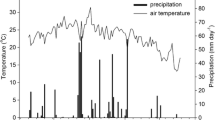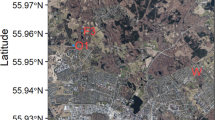Abstract
Methane release rates from rice paddies have been measured in Andalusia, Spain, during almost a complete vegetation period in 1982 using the static box system. The release rates ranged between 2 and 14 mg/m2/h and exhibited a strong seasonal variation with low values during the tillering stage and shortly before harvest, while maximum values were observed at the end of the flowering stage. The CH4 release rate, averaged over the complete vegetation period, accounted for 4 mg/m2/h which results in a worldwide CH4 emission from rice paddies of 35–59×1012 g/yr if we assume that the observed CH4 release rates are representative of global conditions. The CH4 release rates showed diurnal variations with higher values late in the afternoon which were most likely caused by temperature variations within the upper layers of the paddy soils. Approximately 95% of the CH4 emitted into the atmosphere by rice paddies was due to transport through the rice plants. Transport by bubbles or diffusion through the paddy water was of minor importance. Incubation experiments showed that CH4 was neither produced nor consumed in the paddy water. The relase of CH4 from rice paddies caused a diurnal variation of CH4 in ambient air within the rice-growing area with maximum values of up to 2.3 ppmv during the early morning, compared to average daytime values of 1.75 ppmv.
Similar content being viewed by others
References
Aiyer S. P. A., 1919, A methane oxidizing bacterium from rice soils, Agricult. Res. Inst., Pusa, Mem. Dep. Agri., India, Chemical Series, Vol. V, pp. 173–180.
Alberda Th., 1953, Growth and root development of lowland rice and its relation to oxygen supply, Plant & Soil 5, 1–28.
Arashi K. and Nitta H., 1955, Studies on the lysigenous intercellular space as the ventilating system in the culm of rice and some other graminaceous plants, Crop Sci. Soc. Japan Proc. 24, 78–81.
Barber D. A., Ebert M., and Evans N. T. S., 1962, The movement of 15O through barley and rice plants, J. Exp. Bot. 13, 397–403.
Blake D. R., Mayer E. W., Tyler St. C., Makide Y., Montague D. C., and Rowland F. S., 1982, Global increase in atmospheric methane concentrations between 1978 and 1980, Geophys. Res. Lett. 9, 477–480.
Broecker W. S. and Peng T. H., 1974, Gas exchange rates between air and sea, Tellus 16, 1–2, 21–35.
Cicerone R. G. and Shetter G. O., 1981, Sources of atmospheric methane: measurements in rice paddies and a discussion, J. Geophys. Res. 86, 7203–7209.
Cicerone, R. J., Shetter, J. D. and Delwiche C. C., Seasonal variation of methane flux from a California rice paddy, J. Geophys. Res. 88, 11022–11024.
Conrad R. and Seiler W., 1982, Utilization of traces of carbon monoxide by aerobic oligotrophic microorganisms in ocean, lake and soil, Arch. Microbiol. 132, 41–46.
Craig H. and Chou C. C., 1982: Methane: The record in polar ice cores, Geophys. Res. Lett. 9, 1221–1224.
Crutzen, P. J., 1973. A discussion of the chemistry of some minor constituents in the stratosphere and troposphere, Pure Appl. Geophys. 000, 106–108, 1385–1399.
Crutzen P. J. and Gidel L. T., 1983, A two dimensional photochemical model of the atmosphere II: The tropospheric budgets of the anthropogenic chlorocarbons, CO, CH4, CH3Cl, and the effect of various NO x sources on tropospheric ozone, J. Geophys. Res. 88, 6641–6661.
Dacey G. W. H. and Klug M. J., 1979, Methane efflux from lake sediments through water lilies, Science 203, 1253–1255.
Dacey J. W. H., 1980, Internal winds in water lilies: an adaptation for life in anaerobic sediments, Science 210, 1017–1019.
DeBont G. A. M., Lee K. K., and Bouldin D. F., 1978, Bacterial oxidation of methane in a rice paddy, Ecol. Bull. (Stockholm) 26, 91–96.
Dommergues, Y. R. and Rinaudo, G., 1979, Factors effecting N2 fixation in the rice rhizosphere, in Nitrogen and Rice, ed. by The International Rice Research Institute, Los Banos, Philipines, pp. 241–260.
Donner L. and Ramanathan V., 1980, Methane and nitrous oxide: Their effects on the terrestrial climate, J. Atmos. Sci. 37, 119–124.
Ehhalt D. H., 1974, The atmospheric cycle of CH4, Tellus 26, 58–70.
Ehhalt D. H. and Schmidt U., 1978, Sources and sinks of atmospheric methane, Pure Appl. Geophys. 116, 452–464.
Ehhalt D. H., 1979, Der atmosphärische Kreislauf in Methan, Naturwissensch. 66, 307–311.
FAO, 1980, Production Yearbook, Vol. 33.
FAO, 1982, Fertilizer Yearbook, Vol. 31.
Fishman J., Solomon S., and Crutzen P. J., 1979a, Observational and theoretical evidence in support of a significant in-situ photochemical source of tropospheric ozone, Tellus 31, 432–446.
Fishman J., Ramanathan V., Crutzen P. J. and Liu S. C., 1979b, Tropospheric ozone and climate, Nature 282, 818–820.
IRRI, 1975, Changes in Rice Farming in Selected Areas of Asia, ed. by The International Rice Research Institute, Los Banos, Philippines, 377 pp.
IRRI, 1978, Soils and Rice, ed. by The International Rice Research Institute, Los Banos, Philippines, 825 pp.
Khalil M. A. K. and Rasmussen R. A., 1983, Sources, sinks and seasonal cycles of atmospheric methane, J. Geophys. Res. 88, 5131–5144.
Koyama T., 1963, Gaseous metabolism in lake sediments and paddy soils in the production of atmospheric methane and hydrogen, J. Geophys. Res. 68, 3971–3973.
Koyama, T., 1964, Biogeochemical studies on lake sediments and paddy soils in the production of atmospheric methane and hydrogen, in Yasuo Miyaka and T. Koyama (eds.), Recent Researches in the Fields of Hydrosphere, Atmosphere and Nuclear Geochemistry. Murucen, pp. 143–177.
Lacis A., Hansen G., Lee P., Mitchell T., and Lebedeff S., 1981, Greenhouse effect of trace gases, 1970–1980. Geophys. Res. Lett. 8, 1035–1038.
Levy H.II, 1973, Tropospheric budgets for methane, carbon monoxide, and related species, J. Geophys. Res. 78, 5325–5332.
Logan J. A., Prather M. J., Wofsy S. C., and McElroy M. B., 1981, Tropospheric chemistry: A global perspective, J. Geophys. Res. 81, 7210–7254.
Mah R. A., Ward D. M., Baresi L. and Glass T. L., 1977, Biogenesis of methane, Ann. Rev. Microbiol. 31, 309–341.
Mah R. A., 1982, Methanogenesis and methanogenic partnerships, Phil. Trans. Royal Soc. Lond. B 297, 599–616.
Martens Ch. S., 1976, Control of methane sediment-water bubble transport by macroinfaunal irrigation in Cape Lookout Bight, North Carolina, Science 192, 998–1000.
Martens Ch. S. and Klump G. V., 1980, Biogeochemical cycling in an organic-rich coastal marine basin: I. Methane sediment-water exchange processes, Geochim. Cosmochim. Acta 44, 471–490.
Matsuo T., 1969, Morphology and Functions of Rice Plants, 6th. edn. Assoc. Agri. Technol., Tokyo, Japan.
Okajima, H., 1964, Environmental Factors and Nutrient Uptake, Vol. 4, International Rice Research Institute, pp. 63–73.
Rasmussen R. A. and Khalil M. A. K., 1981, Atmospheric methane, trends and seasonal cycles, J. Geophys. Res. 86, 9826–9832.
Robbins R. C., Lavanagh L. A., and Salas L. J., 1973, Analysis of ancient atmospheres, J. Geophys. Res. 78, 5341–5344.
Rudd J. W. M., and Taylor C. D., 1980, Methane cycling in aquatic environments, Adv. Aquat. Microbiol. 2, 77–150.
Seiler W., 1978, The influence of the biosphere on the atmospheric CO and H2 cycles, in W. E.Krumbein (ed.), Environmental Biogeochemistry and Geomicrobiology, Vol. 3, Ann Arbor Science Publ., Ann Arbor, Michigan, pp. 773–810.
Seiler W., and Conrad R., 1981, Field measurements of natural and fertilizer-induced N2O release rates from soils, J. Air Pollut. Control Assoc. 31, 767–772.
Takai Y., 1970, The mechanism of methane fermentation in flooded paddy soil, Soil Sci. Plant. Nutr. 16, 238–244.
Waid, G. S., 1974, Decomposition of roots, in C. H. Dickinson and G. J. F. Pugh (eds.), Biology of Plant Litter Decomposition, Vol. 1, London, pp. 175–211.
Wang W. C., Yung Y. L., Lacis A. A., Mo T., and Hansen G. E., 1976, Greenhouse effect due to man-made perturbations of trace gases. Science 194, 685–690.
Watanabe I. and Furusaka C., 1980, Microbial ecology in flooded rice soils, Adv. Microbiol. Ecol. 4, 125–168.
Wofsy S. C., 1976, Interactions of CH4 and CO in the earth's atmosphere, Ann. Rev. Earth Planet Sci. 4, 441–469.
Wolfe R. S., 1979, Methanogens: A surprising microbial group, Ant. Leeuwenhoek 45, 353–364.
Yamane J. and Sato K., 1967, Effect of temperature on the decomposition of organic substances in flooded soil. Soil Sci. Plant Nutr. 13, 94–100.
Yoshida T., 1975, Microbial metabolism in flooded soils, in E.AlPaul and A. D.MacLaren (eds.), Soil Biochemistry, Vol. 3, Marcel Dekker, New York, pp. 83–122.
Yoshida S., 1981, Fundamentals of Rice Crop Science, The international Rice Research Institute, Los Banos, Philippines.
Zehnder G. B., 1978, Ecology of methane formation, in R.Mitchell (ed.), Water Pollution Microbiology, Vol. 2, Wiley-Interscience, New York, 349–376.
Zeikus J. G. and Winfrey M. R., 1976, Temperature limitation of methanogenesis in aquatic sediments, Appl. Environ. Microbiol. 31, 99–107.
Zeikus J. G., 1977, The biology of methanogenic bacteria, Bact. Rev. 41, 514–541.
Author information
Authors and Affiliations
Rights and permissions
About this article
Cite this article
Seiler, W., Holzapfel-Pschorn, A., Conrad, R. et al. Methane emission from rice paddies. J Atmos Chem 1, 241–268 (1983). https://doi.org/10.1007/BF00058731
Received:
Revised:
Issue Date:
DOI: https://doi.org/10.1007/BF00058731




